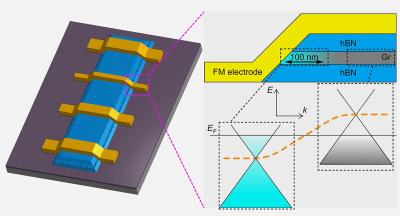Researchers control tiny magnetic states within ultrathin, 2D van der Waals magnets
Researchers at the University of Wyoming, Pennsylvania State University, Northeastern University, The University of Texas at Austin, Colorado State University and Japan's National Institute for Materials Science have developed a method to control tiny magnetic states within ultrathin, two-dimensional van der Waals magnets - a process similar to how flipping a light switch controls a bulb.
The team developed a device known as a magnetic tunnel junction, which uses chromium triiodide - a 2D insulating magnet only a few atoms thick - sandwiched between two layers of graphene. By sending a tiny electric current called a tunneling current through this sandwich, the direction of the magnet's orientation of the magnetic domains (around 100 nanometers in size) can be dictated within the individual chromium triiodide layers.
